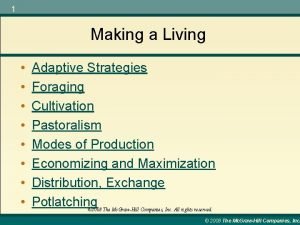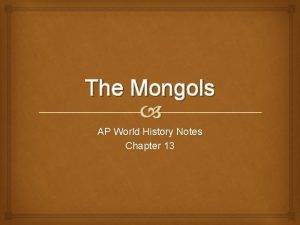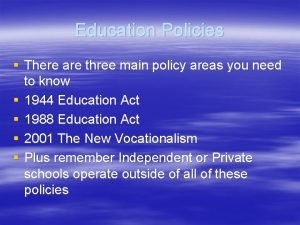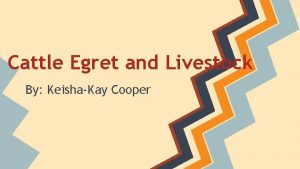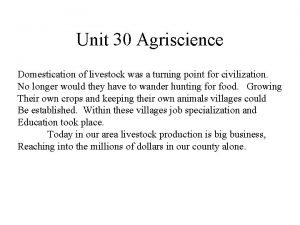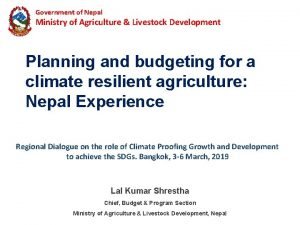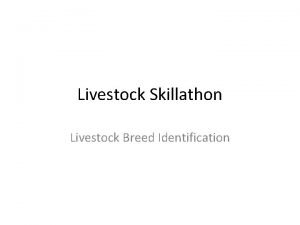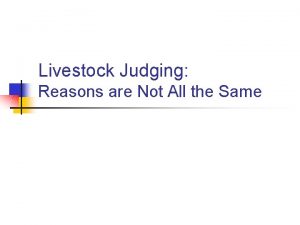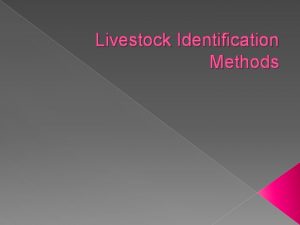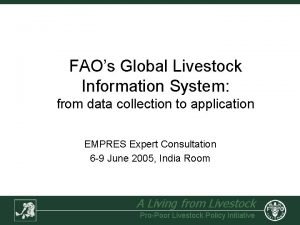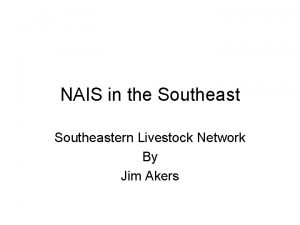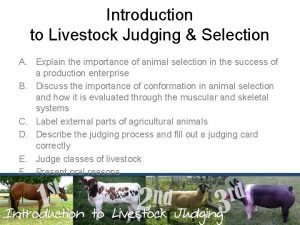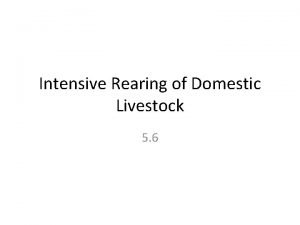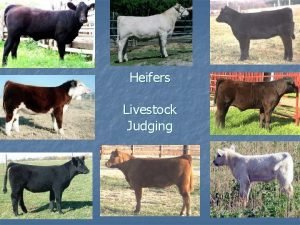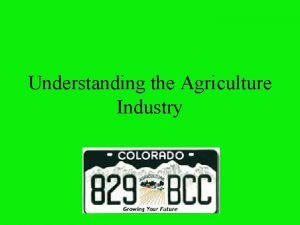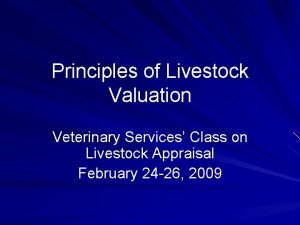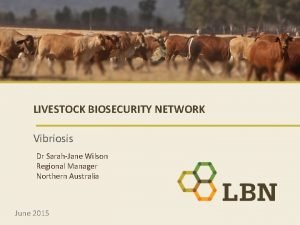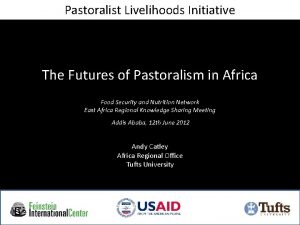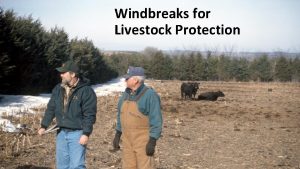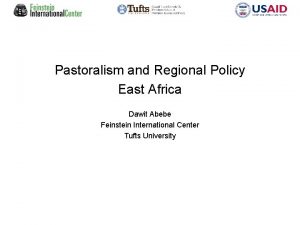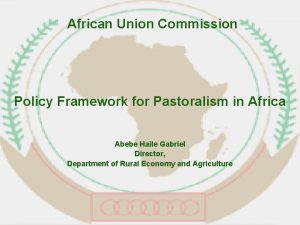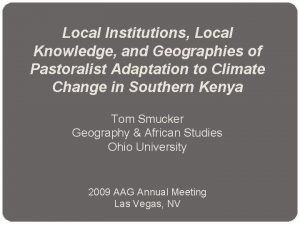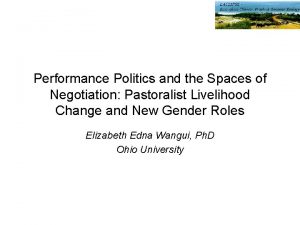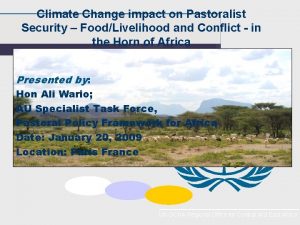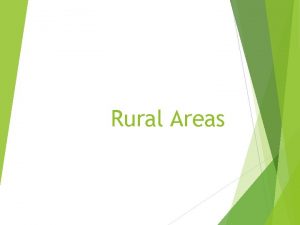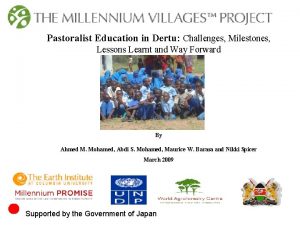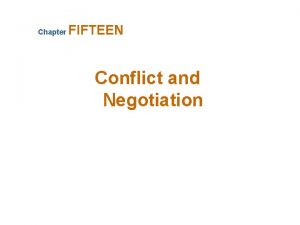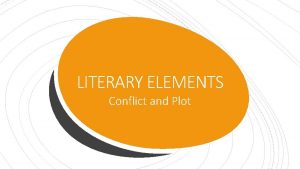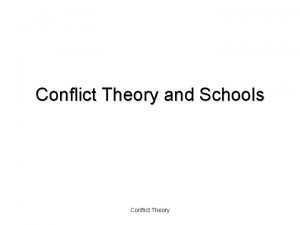Conflict in Pastoralist Areas Pastoralism Livestock and Policy
























- Slides: 24

Conflict in Pastoralist Areas Pastoralism, Livestock and Policy Training Part Two: Mobility Matters Andy Catley

Session overview • • Types and location of conflict in pastoral areas Causes of conflict Impacts of conflict Responses to conflict – government, NGOs, RECs, AU, others • Recent developments – ‘terrorism’ • Implications for a COMESA regional food security policy for pastoral areas

Types and location of conflict in pastoral areas of the COMESA region • Mapping exercise

Some of the main pastoralist areas of the COMESA Region Somalia - Observer status - Mainly pastoral Pastoral population ~ 25 million

Major conflicts affecting pastoralist food security in the Horn of Africa Ø Ø Ethiopia Ogaden region - protracted Somalia - protracted Sudan Darfur - protracted Uganda Karamoja - protracted Many of these conflicts have important regional characteristics … Ø Recent flashpoint – Eritrea and Djibouti

Causes of conflict (1) Ø Historical factors e. g. Ø Colonial borders cutting through traditional pastoral social groupings and ecosystems Ø The Cold War Ø Old grievances and mistrusts, largely unresolved Ø The current geopolitical context – the ‘Global War on Terror’ Ø Pastoralist areas perceived as high-risk Ø Winners and losers – the political economy of protracted conflict

Causes of conflict (2) • Competition over diminishing natural resources – pasture and water – due to encroachment of pastoral lands by agriculture, irrigation schemes and more dominant/powerful pastoral groups etc • The culture of livestock raiding now exacerbated by modern weapons • Commercial raiding • ‘Guns for hire’ • Political manipulation, political marginalization • Misguided ‘disarmament’ efforts • Chronic poverty and food insecurity – violence as a means to acquire assets

Causes of conflict (3) • Many of the causes of conflict in pastoral areas now relate to one central factor … …governance • A fundamental role of government is to protect the security of citizens

Impact of conflict (1) Livelihoods analysis – the framework Vulnerability context CONFLICT Shocks Trends. AND Seasonality VIOLENCE Assets Policies, Institutions, Processes (PIPS) Governance Private sector Policies - formal Policies – informal Laws Culture Social norms Professional norms Livelihoods strategies Livelihood outcomes e. g. More income Reduced vulnerability Better food security Increased wellbeing and so on …

Impact of conflict (2) • The main victims of civil and international conflicts are civilians not armed combatants – physical injury, mental trauma, death • Women and children are particularly badly affected • Rape and mutilation of women and girls is a tactic of war and counter-insurgency • Destruction of health facilities and vaccination campaigns • Destruction of education facilities • Destruction/damage to water supplies etc – disease outbreaks • Child soldiers e. g. South Sudan HUMAN CAPITAL

Impact of conflict (3) • • • Direct and violent depletion of financial assets e. g. livestock, is a tactic or war and counter-insurgency Disruption of markets – implications for pastoralists Breakdown of veterinary services – no preventive or curative services Limited private sector investment – high risks of doing business and trade Restrictions on movement – seasonal labor migration and remittances High government military expenditure FINANCIAL CAPITAL

Impact of conflict (4) • • • Destruction or contamination of water sources as a tactic or war and counter -insurgency Restricted movement limits access to grazing areas; overgrazing of accessible areas; restricted cross-border movements ‘No mans land’ areas between conflicting groups Landmines and unexploded ordnance Breakdown of traditional institutions for NRM Scorched earth tactics NATURAL CAPITAL

Impact of conflict (5) • Forced migration – internal and international displacement; break-up of families and communities • Breakdown of traditional safety nets/social support • Breakdown of traditional leadership and institutions • New and violent ‘social norms’ SOCIAL CAPITAL

Impact of conflict (6) • Destruction or damage to roads and physical infrastructure • Destruction of government offices and records • Breakdown of communication and transport PHYSICAL CAPITAL

Impact of conflict (7) • Conflict and violence damages or destroys the five main types of livelihoods asset – human, financial, social, natural and physical • The Horn of Africa – and especially pastoral areas - remain chronically food insecure largely because of conflict • Conflict is the key causative factor in the ‘protracted crises’ or ‘complex emergencies’ which characterize some pastoral areas • In other pastoral areas, local conflicts and raiding undermine development and investment, and contribute to chronic food insecurity

Responses to conflict (1) • • Government responses Regional bodies and AU NGOs and civil society – conflict resolution Humanitarian actors – Sphere and protection • The political economy of conflict

Responses to conflict (2) • Government responses include: – Dialogue and negotiation – Conflict early warning systems – District peace committees (or equivalent) – Police or military action/violence – Support to militias – Disarmament

Responses to conflict (3) • Regional and AU responses include: – Facilitation of dialogue and negotiation – Conflict early warning systems – Peace keepers – AU/IBAR Community-based approaches in the Karimojong Cluster

Responses to conflict (4) • NGO and civil society responses – conflict resolution and management: – Community-based approaches: • • Village peace committees or similar Involvement of women Facilitation of local dialogue and negotiation Support to traditional peace meetings – Advocacy – Research and documentation

Responses to conflict (5) • Humanitarian actors – The Geneva Convention, the Red Cross movement, international rights-based humanitarian laws and conventions – The emergence of the Humanitarian Charter and Minimum Standards in Disaster Response (the Sphere Project) – The re-emergence of ‘protection’ as a core principle of humanitarian action

Responses to conflict (6) • Political economy of conflict: – Who benefits from ‘informal trade’ and tactical asset depletion during conflict? – What are the incentives for some actors to maintain conflict? – The problem of information, witness, testimony and analysis in remote pastoral areas affected by conflict; access issues

Regional issues and GWOT Three narratives “The principle of free movement of people, goods and services is highly relevant to crossborder pastoral areas because it supports the inherently crossborder nature and efficiency of pastoral production systems and livelihoods. ” “The principle of free movement of people, goods and services contradicts our anti-terrorism agenda. We need to tightly control our border as part of our strategy to prevent terrorism”. “The answer is not tighter border control and restrictions, but development. When people see government providing services, the relationships between government and communities will improve, and so will security”.

Some implications for a COMESA regional food security policy for pastoral areas • Analysis of conflict is crucial – e. g. causes, political economy, governance issues; costs of conflict • Protracted crises/complex emergencies: – Market-based and livelihoods approaches to food security programming are often possible (cf. food aid) – See experiences from South Sudan, Nuba Mountains and southern Somalia

Some implications for a COMESA regional food security policy for pastoral areas • Lower level conflict environments - typical development strategies such as market support, trade and private sector investment are all hindered by conflict; governance issues have to feature in food security strategies? • Land tenure policies and laws • Cross-border issues – a particular challenge for COMESA? How to rationalize the economic and ecological logic of trans-boundary pastoral livelihoods with security agendas …peace and development dividends • Harmonized approaches and consistent messages – links with other RECs and AU
 Yehudi cohen adaptive strategies
Yehudi cohen adaptive strategies Chapter 13 ways of the world notes
Chapter 13 ways of the world notes List of policy areas
List of policy areas Cattle egret and cattle symbiotic relationship
Cattle egret and cattle symbiotic relationship Livestock breed identification swine - vocabulary
Livestock breed identification swine - vocabulary Ministry of agriculture and livestock development
Ministry of agriculture and livestock development Internal and external conflict worksheet
Internal and external conflict worksheet What is conflict and conflict resolution?
What is conflict and conflict resolution? Internal and external conflict
Internal and external conflict Livestock breed identification
Livestock breed identification Livestock judging transition terms
Livestock judging transition terms Livestock judging reasons
Livestock judging reasons Livestock risk management brokers near me
Livestock risk management brokers near me Livestock classification chart
Livestock classification chart Livestock identification methods
Livestock identification methods Livestock information system
Livestock information system Parasites of livestock vocabulary
Parasites of livestock vocabulary Livestock network
Livestock network Livestock judging card
Livestock judging card Intensive rearing of livestock
Intensive rearing of livestock Livestock judging basics
Livestock judging basics Colorado livestock
Colorado livestock Livestock valuation methods
Livestock valuation methods Livestock biosecurity network
Livestock biosecurity network Judging 101
Judging 101
